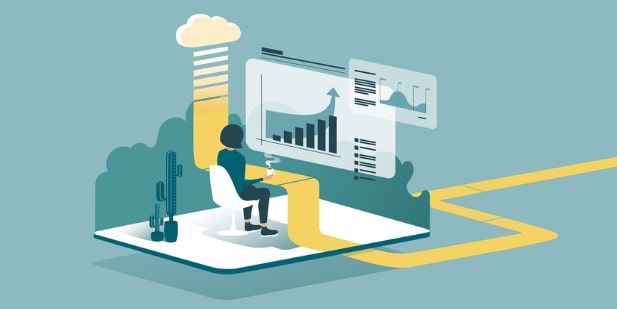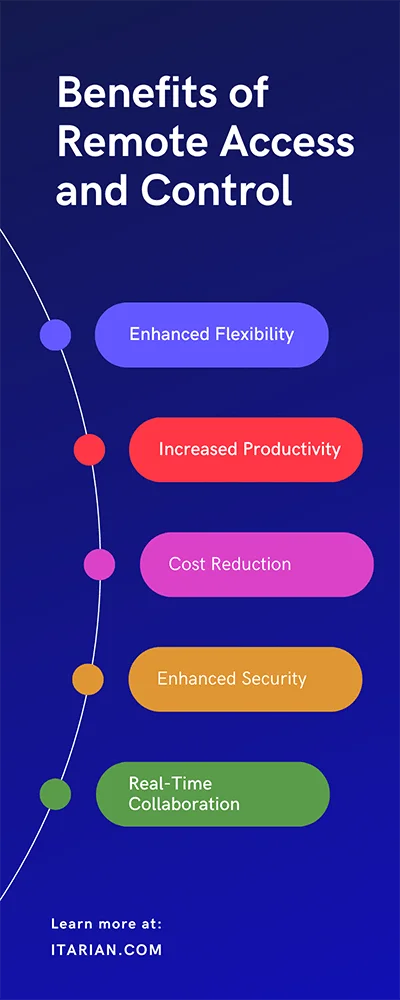What is Remote Access and Control?
Remote access and control refers to the technology and protocols that allow individuals or systems to access, manage, and control computing resources or data from a location distinct from where the resources are hosted. This technology has become integral in a world that increasingly values flexibility, mobility, and the capacity to stay connected and productive irrespective of physical location.
The fundamental principle behind remote access and control is connecting to a device or network from a distance. This connection can be established over the internet or other networks, enabling users to access and control devices as if they were physically present. It's a cornerstone for many contemporary applications, including telecommuting, remote IT management, and accessing resources stored in the cloud.

There are diverse forms of remote access, each serving distinct needs and contexts. For instance, Virtual Private Networks (VPNs) allow users to access network resources remotely, ensuring the connection is secure and private. Remote Desktop Services (RDS) enable users to view and control the desktop of a remote computer, often used in technical support and IT management. Meanwhile, cloud services allow users to store, access, and manage data housed in remote servers.
Security is paramount in remote access and control. Given that users can access systems from anywhere in the world, potential security vulnerabilities can be exploited by malicious entities. Therefore, robust encryption, multi-factor authentication, and stringent access controls are essential to remote access solutions. These measures ensure that only authorized individuals or systems can access and control remote resources.
One of the prominent benefits of remote access and control is the increased flexibility it affords users. In an era where work, learning, and interaction have become more fluid and less constrained by geographic location, accessing and controlling resources remotely is invaluable. It facilitates collaboration, productivity, and responsiveness that was previously challenging to achieve.
Moreover, businesses can leverage remote access and control to optimize their operations. IT professionals can manage and troubleshoot systems without being physically present, reducing downtime and operational disruptions. Employees can access their work environments from anywhere, enhancing productivity and ensuring that business processes continue smoothly despite unforeseen challenges like natural disasters or pandemics.
However, the ubiquity of remote access and control also raises pertinent questions about privacy and security. As much as these technologies have empowered users, they have also introduced new vulnerabilities. Cybersecurity measures must evolve in tandem with the development of remote access technologies to mitigate risks associated with unauthorized access, data breaches, and other cyber threats.
Benefits of Remote Access and Control
Remote access and control offer numerous benefits that enhance efficiency, productivity, and security in various operational contexts. These benefits are pivotal for businesses and individual users who require flexible access to computers and networks. Below, we outline some key advantages that have propelled the widespread adoption of remote access and control technologies.
Enhanced Flexibility
One of the standout benefits of remote access and control is the flexibility it grants users. Individuals can access files, software, and networks from anywhere worldwide, breaking down geographical barriers. This flexibility is vital for businesses with a global footprint, enabling seamless collaboration and real-time access to essential resources.
Increased Productivity
Remote access boosts productivity by ensuring employees can work efficiently from anywhere. Whether working from home, in a client's office, or while traveling, remote access provides that the tools and files are always at one's fingertips. This convenience translates to increased work output and efficiency.
Cost Reduction
For businesses, remote access means reduced operational costs. With employees able to work remotely, companies can cut down on office space, utilities, and other associated expenses. Furthermore, remote IT support reduces the need for on-site visits, saving time and resources.
Improved Business Continuity
Remote access ensures business operations can continue unhampered in unexpected disruptions such as natural disasters, pandemics, or technical issues. Employees can work from safe locations, and IT professionals can address technical issues remotely, ensuring minimal downtime.
Enhanced Security
When implemented with robust security protocols, remote access and control can enhance an organization's security posture. Features like encryption, multi-factor authentication, and strict access controls ensure that sensitive data and systems are accessed only by authorized personnel.
Real-Time Collaboration
In a globalized world, teams are often dispersed across different locations. Remote access enables real-time collaboration, with team members able to instantaneously access, edit, and share documents and resources. This facilitates streamlined workflows and improved communication.
Customized User Experiences
Remote access and control technologies can be tailored to meet specific user requirements and preferences. Users can access a familiar desktop environment, applications, and settings, ensuring a personalized and efficient working experience.

Eco-Friendly Practices
With the reduced need for commuting and the operation of large office spaces, remote access contributes to eco-friendly practices. It aids in reducing carbon footprint, aligning with the global shift towards more sustainable operational practices.
In wrapping up, the benefits of remote access and control are multifaceted, touching on operational efficiency, cost reduction, and environmental sustainability. As technology advances, it is anticipated that these benefits will become even more pronounced, with enhanced features offering more streamlined, secure, and flexible remote access options for diverse user needs. However, adaptation and implementation of robust security measures and policies will be fundamental to harnessing the full potential of these technologies while mitigating associated risks.
Remote Access and Control FAQ
Answer: Remote access and control works by connecting a user or system to a device, network, or computer at a different location. This connection can be facilitated through the internet or other types of networks. Using specific protocols and software, users can access, manage, and control the remote system as if they were physically present, performing tasks like file transfer, software installation, and system monitoring.
Answer: The safety of remote access largely depends on the security measures in place. Remote access can be safe when equipped with robust security protocols like encryption, multi-factor authentication, and strict access controls. Users and administrators must keep software updated, use strong passwords, and follow best security practices to mitigate potential risks and vulnerabilities.
Answer: Yes, remote access and control are versatile and can be used across various operating systems, including Windows, macOS, Linux, and mobile OS like iOS and Android. Different software solutions are available, catering to each operating system's specific needs and compatibilities, ensuring seamless remote connectivity.
Answer: Remote access and control are widely used for telecommuting, allowing employees to access work resources from home or other locations. It's also essential for IT support, enabling technicians to connect to users' computers remotely to troubleshoot and resolve issues. Other uses include:
- Remote learning.
- Managing servers.
- Accessing files and applications on the go.
- Collaborating on projects in real-time.
Answer: Ensuring the security of remote access involves several steps. Implement strong passwords and multi-factor authentication to verify user identity. Use encryption to protect data transmission over the internet. Regularly update and patch the remote access software to fix vulnerabilities. Set up firewalls and intrusion detection systems to monitor and block suspicious activities. Lastly, educate users on security best practices to avoid potential threats.
Answer: While remote access and control offer numerous benefits, there are also limitations. Potential latency issues can affect real-time access and control, especially over long distances or unreliable networks. Security is a constant concern, requiring vigilant monitoring and updating of security protocols. The user experience might also be affected depending on the remote access solution and the devices being used.
